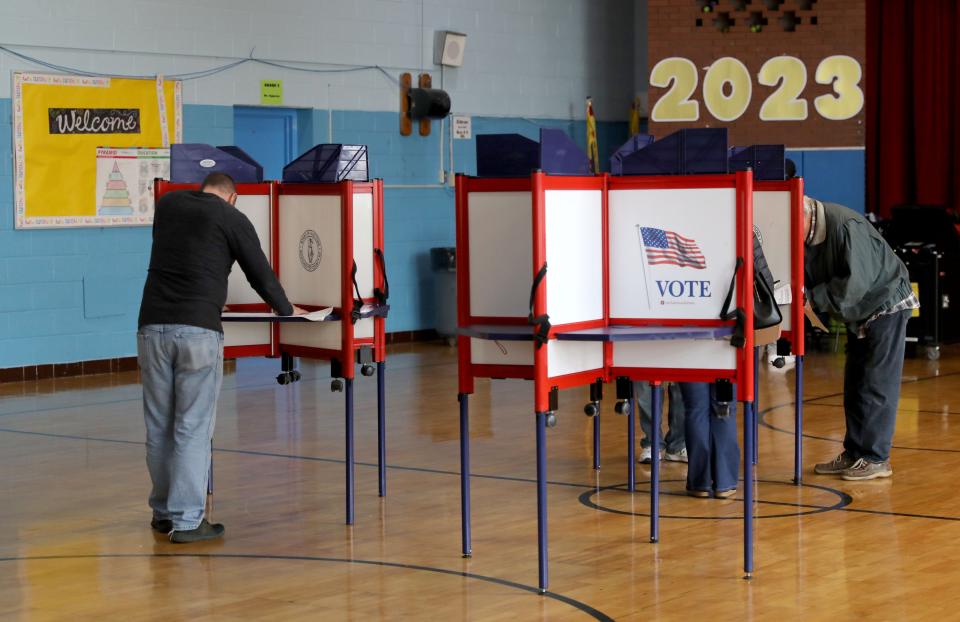Should Hochul sign bill moving local elections in order to boost voting turnout?
- Oops!Something went wrong.Please try again later.
Dutchess County's nearly 200,000 voters had a chance on Tuesday to pick a new leader for a local government that taxes them, provides public services and employs hundreds of people.
Fewer than 70,000 took that opportunity, electing Republican Sue Serino as county executive by a healthy margin but with just 34% turnout.
To the south in Westchester County, participation was even lower in votes that returned Yonkers Mayor Mike Spano to office for an unprecedented fourth term and made Yadira Ramos-Herbert the first new mayor of New Rochelle in 17 years. Around 29% of New Rochelle voters cast ballots, and just 24% did so in Yonkers.

It was a familiar odd-year drop in New York. With no federal and state races motivating voters as they do in even-numbered years, fewer voters ventured to the polls to choose candidates in mostly county and municipal races that don't pack the same political charge.
The contrast is stark. A year ago, nearly 280,000 Monroe County voters cast ballots in Gov. Kathy Hochul's race against Republican challenger Lee Zeldin. But just half that number voted for county executive on Tuesday, a contest that Democratic incumbent Adam Bello won by a huge margin and with 29% turnout.
NY elections takeaways 3 takeaways on NY elections: A historic win in Yonkers, upstate incumbents triumph
Could a pending NY bill get more people out to the polls?
Hochul is weighing a bill that state lawmakers passed this year that would consolidate some but not all elections in even-numbered years in New York to boost turnout.
Under the proposal, elections for county executive, county legislature and town offices would be moved from odd years to even years, putting them on the same ballots as presidential races and contests for Congress and state legislature. It would start to take effect in 2025 if approved by the governor, who has until Dec. 31 to sign or veto it.
Election shift: NY may move local elections to even years. What does that mean for voter turnout?
A litany of offices are excluded from the bill because of obstacles in the state constitution, including city mayors and council members, sheriffs, district attorneys and county clerks. Elections for those positions could still be held in odd-numbered years, which limits the bill's impact and potential cost savings.

What are the arguments over the bill?
Good government groups such as Common Cause New York support the Democratic-sponsored bill as a boon for voter participation and democracy. They argue that combining elections in even years will mean greater participation and less voting fatigue for voters and poll workers.
Republicans strongly oppose it and call it a power grab by Democrats, assuming Democratic candidates would benefit if more people vote. They and other groups also pose a more neutral objection: that putting local candidates on the same ballots as state and federal ones will distract voters from strictly local campaign issues.
"I feel local elections will be overshadowed by the large media sensationalism of Presidential, Congress and State campaigns," Town of Newburgh Supervisor Gil Piaquadio, a Republican, told Hochul in a letter urging her to veto the bill. "In addition, there will be so many candidates for the voter to consider, the voter may well drop off and never reach the local candidates at the end of the ballot."
Democrats see both pros and cons. Westchester County Democratic Chairwoman Suzanne Berger argues the bill could both boost turnout for races moved to even years and reduce voting in those that remain stranded in odd years. Another potential pitfall, she said, is adding so many races to a ballot that it requires two pages.
But she disputed the partisan aspect by saying higher turnout in Republican areas would likely benefit Republicans, not Democrats.
"It may be emphasizing the dominant party in the area," she said.
State Sen. James Skoufis, a Democrat who sponsored the election consolidation bill, said he plans to propose a constitutional amendment that would allow all elections — including those for district attorney and city offices — to be held in even years so that odd-year elections could end entirely. That would save taxpayers money, he said, as it would cut down the municipal cost of administering elections.
What were turnout levels in other races?
Turnout was consistently lower than 40% in a sampling of Hudson Valley races held on Tuesday.
In Rockland County, around 35% of voters took part in the county's only contested race for town supervisor: Republican George Hoehmann's successful bid for re-election in Clarkstown.
In Westchester County, turnout was at 33% in the Cortlandt town supervisor race, and ranged from 30% to 35% in the county legislative districts 1, 4 and 10.
Further upstate, 29% of Onondaga County voters cast ballots in the county executive race that GOP incumbent Ryan McMahon won, and 32% of Erie County voters took part in Democratic County Executive Mark Poloncarz's glide to re-election.
Chris McKenna covers government and politics for The Journal News and USA Today Network. Reach him at cmckenna@gannett.com.
This article originally appeared on Rockland/Westchester Journal News: NY Elections: Could moving local races to even years boost turnout?

